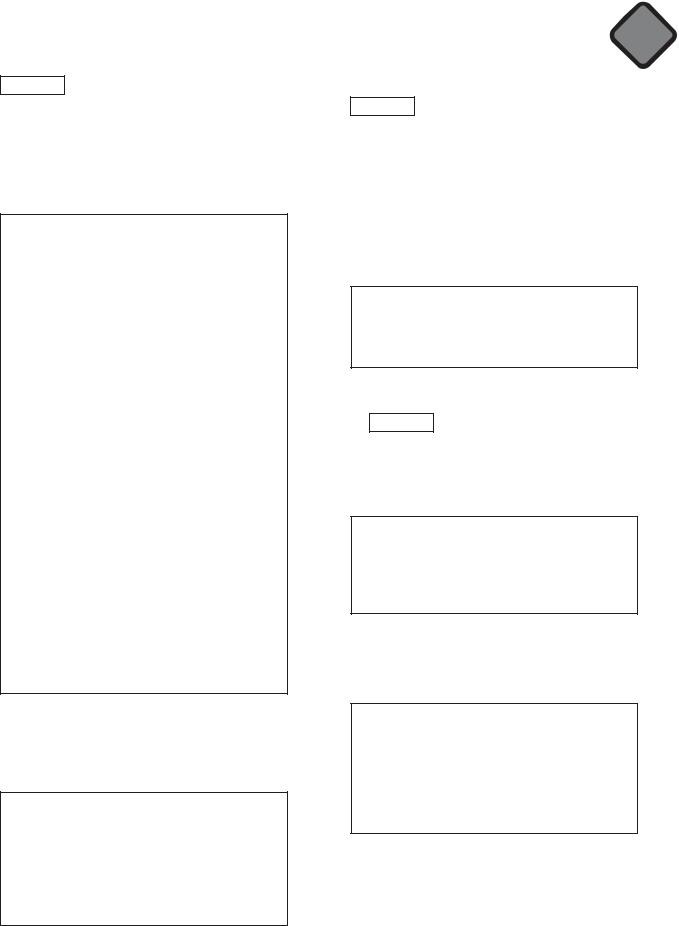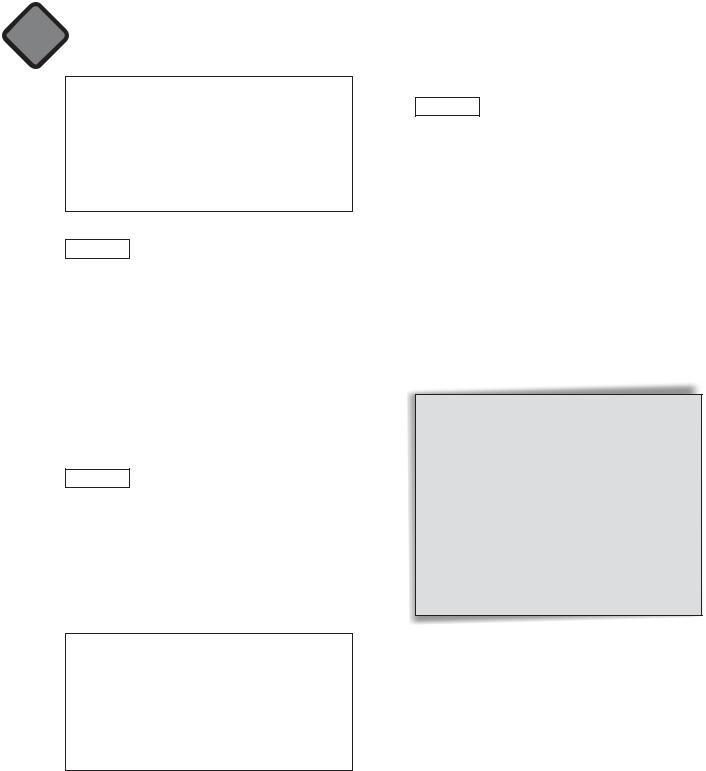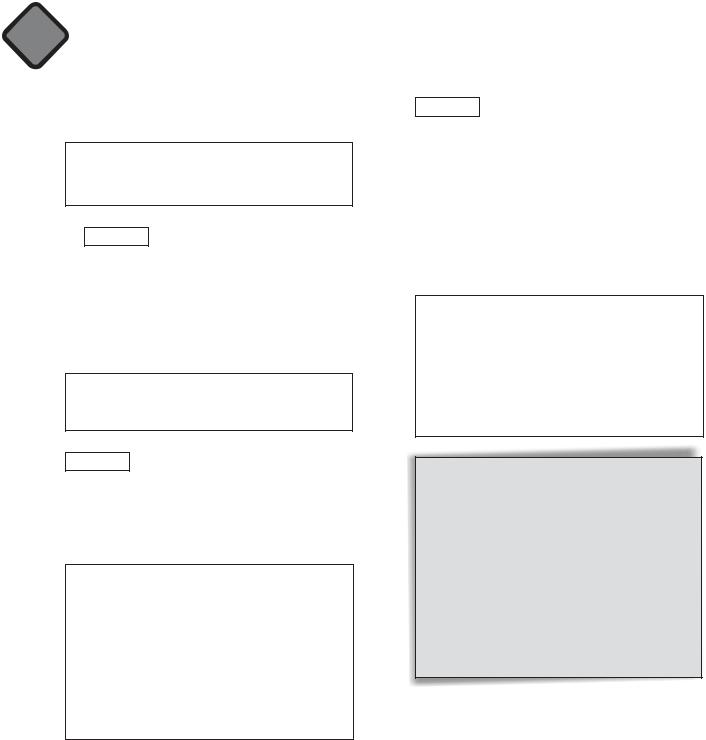
Sportlight_7
.pdf
places in the pictures. Allow time for Ss to think of a question. Ask some Ss what their questions are and write them on the board. Allow Ss time to read or listen to the texts to see if they can find answers to the questions. Discuss the questions and answers with the class.
Suggested Answer Key
How many towers has Conwy Castle got? How old is Malahide Castle?
How many tourists visit Edinburgh Castle every year?
What is a Yeoman/Beefeater?
b) Focus Reading for specific information
Ask Ss to read the text again and complete the task. Ss compare answers. Select a few Ss to say what facts they found unusual. Stimulate discussion.
Suggested Answer Key
People often see ghosts in Malahide castle. Edinburgh Castle is built on an extinct volcano. Conwy castle took seven years to build.
A legend says that if the ravens ever fly away from The Tower of London, it will fall down.
3Focus Building vocabulary
ñAsk Ss to read the text again and then to explain the words in bold. Encourage Ss to guess the meanings from the context and to explain words in bold by giving explanations, examples or synonyms, or by using their dictionaries if necessary. Finally, explain the meaning of any words Ss still don’t understand.
Answer Key
dates back (v): comes from the time fortress (n): a type of castle spooky (adj): scary
ghosts (n): imaginary images of dead people medieval (adj): period from 476 A.D to 1453 A.D. towers (n): tall narrow buildings, often part of a castle
views (n): what you see from a place unique (adj): the only one of its kind
Culture Corner 1d
extinct volcano (exp): a volcano that longer active
guarded by (exp): protected by ravens (n): black birds like crows legend (n): a very old popular story
ñDivide the class into small groups. for Ss to look back at the texts and to some questions about the places
Each group asks another group a question the texts. If the group answers correctly, to ask another group a question. If not, group can answer and then ask, and so on.
Suggested Answer Key
A:Why is Malahide castle spooky?
B:Because people often see ghosts there.
A:How many people visit Endinburgh Castle every year?
B:One million people. etc
Writing
4Focus Expressing preference
Ss work in pairs. Read the rubric and explain the task. Allow Ss time to perform the task. Go around the classroom monitoring Ss’ work and helping where necessary. When Ss have finished their pair work, invite individual Ss to tell the class what castle their partner likes and why.
(Ss’ own answers)
5Focus Portfolio: Writing a short essay
about landmarks in your country
Read the rubric and explain the task. Refer Ss back to the texts and tell them they can use them as a model. Go through the plan with Ss and organize their ideas into paragraphs. Provide Ss with maps or allow them to use a map from a geography book, or provide information about places on printouts or from magazines. Allow Ss time to complete the task in class. Ss compare their work. Check Ss’ work and give feedback. Alternatively, you can assign the task for HW provided you have gone through it orally in class. Tell Ss to look for articles and maps in magazines or on the Internet and to write their text. Correct Ss’ work in the next lesson.
21

1d Culture Corner
Suggested Answer Key
Red Square is in the centre of Moscow. There are lots of things to see there. Firstly, the Spassky Tower, built in the 16th century, has a beautiful tower clock. You can also see the Lenin Mausoleum.
The Sphinxes of St Petersburg stand over the Neva River. They are about 3500 years old and come from Egypt. They weigh more than 23,000 kg. Every year, thousands of tourists come to see the two … etc
1 |
|
|
English in Use |
|
|
|
|
|
|
|
|
|
|
|
|
|
|
|
|
||||
|
|
|
|
Buying an underground ticket |
|
|
|
|
|
|
|
|
|
||||||||||
|
|
|
|
|
|
|
|
|
|
|
|
|
|
|
|
|
|
||||||
|
|
|
|
|
|
|
|
Answer Key |
|
|
|
|
|||||||||||
Ask Ss how they usually travel. Encourage discussion |
|
|
A wants to go to St. James’ Park. |
|
|||||||||||||||||||
|
|
B wants to go to Barbican. |
|
||||||||||||||||||||
about the different forms of transport. Elicit/Explain |
|
|
|
||||||||||||||||||||
|
|
|
|
|
|
|
|
|
|
|
|
||||||||||||
what public transport is. Ask Ss to read the words in |
|
|
|
|
|
|
|
|
|
|
|
|
|||||||||||
the box and to say which are public transport. Write |
3 |
|
|
Role play: buying an underground ticket |
|||||||||||||||||||
|
Focus |
||||||||||||||||||||||
the correct answers on the board. |
|
|
|
|
|
|
|
|
|
|
|
|
|
|
|
||||||||
|
|
|
Focus Ss’ attention on the map of the London |
||||||||||||||||||||
|
|
|
|
|
|
|
|
|
|
|
|||||||||||||
|
|
Answer Key |
|
|
|
|
|
Underground and the three destinations. Practise |
|||||||||||||||
|
|
train, bus, plane, tube, boat, ship |
|
|
|
the pronunciation of place names if necessary. Ask a |
|||||||||||||||||
|
|
|
|
|
|
|
|
|
|
|
S to read the rubric and explain the task to the class. |
||||||||||||
|
|
|
|
|
|
|
|
|
|
|
|||||||||||||
|
|
|
|
|
|
|
|
|
|
|
Tell Ss to look back at dialogue B in the previous |
||||||||||||
2 a) |
Focus |
Listening for specific information |
|||||||||||||||||||||
exercise so they can use it as a model. Write on the |
|||||||||||||||||||||||
|
|
|
Elicit/Explain the meaning of ticket seller and |
||||||||||||||||||||
|
|
|
board – Liverpool Street |
to Westminster 2 adults |
|||||||||||||||||||
|
|
|
passenger. Go through the phrases with Ss. Ask |
(£6), two children (£3.) Go through the dialogue |
|||||||||||||||||||
|
|
|
Ss to say who would say what. |
|
|
|
outline on the board. Ask a pair of Ss to role play the |
||||||||||||||||
|
|
|
|
|
|
|
|
|
|
|
dialogue. Ask another pair to role play the dialogue |
||||||||||||
|
|
Answer Key |
|
|
|
|
|
||||||||||||||||
|
|
|
|
|
|
|
for another trip and so on. |
|
|
|
|
||||||||||||
|
|
Ticket Seller |
Passenger |
|
|
|
|
|
|
|
|||||||||||||
|
|
|
|
|
|
|
|
|
|
|
|
|
|
|
|
|
|||||||
|
|
Next please. |
Return to Barbican |
|
|
|
Dialogue outline |
|
|
|
|
||||||||||||
|
|
Where to? |
Which line do I take, please? |
|
|
|
|
|
|
|
|
|
|
|
|
|
|||||||
|
|
Ticket Seller |
|
|
|
Passenger |
|||||||||||||||||
|
|
Single or return? |
|
|
|
|
|
|
|
|
|
|
|||||||||||
|
|
|
|
|
|
|
|
|
|
|
|
|
|
|
|
|
|
|
|||||
|
|
That’s £6.00. |
|
|
|
|
|
|
|
Greet passenger. |
|
|
|
|
|
|
Say how many tickets |
||||||
|
|
|
|
|
|
|
|
|
|||||||||||||||
|
|
You’re welcome. |
|
|
|
|
|
|
|
|
|
|
|
|
|
|
|
you want and where |
|||||
|
|
|
|
|
|
|
|
|
|
|
|
|
|
|
|
|
|
|
|
|
|||
|
|
|
|
|
|
|
|
|
|
|
|
|
Tell passenger how |
|
|
|
|
you want to go. |
|||||
|
|
|
|
|
Listening for specific information |
|
|
|
|
|
|
Pay and ask for |
|||||||||||
b) |
Focus |
|
|
|
|
|
|
||||||||||||||||
|
|
|
|||||||||||||||||||||
|
|
|
|
|
|
|
|
|
|
|
|
|
much it costs. |
|
|
|
directions. |
||||||
|
|
|
Read the rubric and explain the task. Play the |
|
|
|
|
|
|||||||||||||||
|
|
|
|
|
Tell passenger what |
|
|
|
|
|
Thank ticket seller. |
||||||||||||
|
|
|
recording of |
the first |
dialogue |
(twice |
if |
|
|
|
|
|
|
||||||||||
|
|
|
|
|
line to take. |
|
|
|
|
|
|||||||||||||
|
|
|
necessary). Ss |
listen and |
complete |
the task. |
|
|
|
|
|
|
|
||||||||||
|
|
|
|
|
End conversation |
|
|
|
|
|
|||||||||||||
|
|
|
Check Ss’ answers. Play the recording of |
the |
|
|
|
|
|
|
|
||||||||||||
|
|
|
|
|
politey. |
|
|
|
|
|
|||||||||||||
|
|
|
second dialogue (twice if necessary). Ss listen |
|
|
|
|
|
|
|
|||||||||||||
|
|
|
|
|
|
|
|
|
|
|
|
|
|
|
|||||||||
|
|
|
|
|
|
|
|
|
|
|
|
|
|
|
|||||||||
|
|
|
and complete the task. Check Ss’ answers. |
|
|
|
|
|
|
|
|
|
|
|
|
|
|
||||||
22

Suggested Answer Key
TS: Yes, please?
PS: Two adults and two children to Westminster. TS: That’s £9, please.
PS: Here you are. Which line do we take, please?
TS: Take the Circle Line. PS: Thanks.
TS: You’re welcome!
Pronunciation
4Focus Pronouncing /∞/, /æ/
Focus Ss’ attention on the phonemes chart in the appendix. Ask them to find the two symbols. Pronounce the sounds clearly and slowly.
English in Use 1
Demonstrate where your tongue, teeth and jaw are positioned for the sound. Ss listen and repeat. Drill sounds around the class. Read the rubric and explain the task. Play recording. Ss listen and tick the correct boxes. Ss compare answers. Check Ss’ answers and correct any mistakes.
Suggested Answer Key
|
/æ/ |
/∞/ |
|
/æ/ |
/∞/ |
Pete |
|
|
beat |
|
|
pit |
|
|
bit |
|
|
peel |
|
|
slip |
|
|
pill |
|
|
sleep |
|
|
|
|
|
|
|
|
Other words: /æ/: hit, sit, ship; /∞/: heat, seat, sheep
Reading & Listening
1Focus Predicting information
Draw Ss’ attention to the pictures. Tell them they are going to listen to some sounds. Go through the list of adjectives and explain any unknown words. Ask Ss to decide what each place is like as they listen. Play the recording. Ss listen and then describe what they think each place is like to their partner.
Suggested Answer Key
I think it is a crowded place. It’s very noisy. It’s a busy city with lots of traffic. Maybe it is dirty too.
2 a) Focus Anticipating information
Work with books closed. Ask Ss to think of a few things they would like to know about Mexico City. In pairs, allow Ss time to prepare some questions. Ss compare questions. Write some of the Ss’ questions on the board. Ask Ss to open their books and to read the text to see if they can answer any of the questions. Write answers to questions on the board.
Extensive Reading |
1 |
|
|
Suggested Answer Key
What language do they speak there? They speak Spanish.
How many people live there?
20 million people live there. etc
b)Focus Matching headings to paragraphs
ñAsk a S to read the rubric aloud. Ask another S to read the headings in the box. Check understanding. Allow time for Ss to do the task individually. Play recording. Ss check their answers. Write correct answers on the board.
Answer Key
1 C |
2 D |
3 A |
4 E |
5 B |
ñAsk Ss to explain the meaning of the words in bold without the use of a dictionary ie. they can use synonyms, paraphrase etc. Elicit/ Explain the meanings and write them on the board. Ss should copy the words into the vocabulary section of their notebooks.
23

1 |
Extensive Reading |
|
|
Answer Key
continent (n): a very large area of land population (n): the people living in a country language (n): the words we speak
currency (n): the money of a country
blocks of flats (n): tall buildings with many flats lines (n): tracks on which a metro travels
Making notes/presenting a talk
Ss into groups. Ask them to think about their and to make notes under the headings. Write on the board and brainstorm for ideas.
Ss time to perform the task. Go around the monitoring Ss’ work and helping with any
. Choose a few Ss to present their talk to
class.
own answers)
Project: writing a report
the rubric and explain the task. Refer Ss back the text and tell them they can use it as a
model. Brainstorm ideas and write them on the board. Go through the plan with Ss and organize their ideas in paragraphs. Allow Ss time to complete the task in class. Ss compare and discuss their work. Check Ss’ work and give feedback. Alternatively, you can assign the task for HW provided you have gone through it orally in class.
Suggested Answer Key
St Petersburg is a beautiful city on the Baltic Sea, in the west of Russia. The population of St Petersburg is 4.7 million. It is a very big city and there are lots of things to do there.
There are over 140 museums to visit in St Petersburg. There are also many theatres and cafés to go to in the evenings.
The people of St Petersburg are very friendly and like to have fun and enjoy themselves, so there are many festivals during the summer.
However, the winter can be very long and cold. In the winter people go skating on frozen lakes. Sometimes the traffic can be difficult too.
All in all though, St Petersburg is a great place to be.
1 |
Progress Check |
|
|
Progress Check 1 and Look at Module 2 should be done in one lesson.
Answer Key |
|
|
|
|
|
|
|
|
|
|
|
||
1 |
1 |
E |
3 |
A |
5 |
B |
7 |
F |
4 |
1 |
is visiting |
7 |
Is he doing |
|
2 |
D |
4 |
C |
6 |
H |
8 |
G |
|
2 |
takes |
8 |
do you start |
|
|
|
|
|
|
|
|
|
|
3 |
is sleeping |
9 |
isn’t watching |
2 |
1 |
unhealthy |
|
|
8 |
homesick |
|
4 |
always bites/ |
10 |
doesn’t like |
||
|
2 |
peace |
|
|
|
9 |
installing |
|
|
is always biting |
11 |
are they leaving |
|
|
3 |
unemployment |
|
10 |
constant |
|
5 |
doesn’t boil |
12 |
I don’t think |
|||
|
4 |
break |
|
|
|
11 |
lonely |
|
|
6 |
leaves/is leaving |
|
|
|
5 |
bustle |
|
|
|
12 |
rent |
|
|
|
|
|
|
|
6 |
chatting |
|
|
13 |
play |
|
5 |
1 |
One ticket please. |
|
|
|
|
7 |
convenient |
|
14 |
close |
|
|
2 |
Return to Oxford Circus. |
|
|||
|
|
|
|
|
|
|
|
|
|
3 |
That’s £3.00. |
|
|
3 |
1 |
out |
2 |
after |
3 |
from |
4 |
about |
|
4 |
Which line do I take? |
|
|
|
|
|
|
|
|
|
|
|
|
5 |
Thanks a lot. |
|
|
24

Tale time
Before you start …
This section helps Ss quickly revise vocabulary, language and grammar skills seen in the previous module. Ss consolidate their learning through interaction.
Ask Ss to take a quick look at Module 1. Ask Ss about where they live and if they like living there. Ask them about their free-time activities. Ask questions and stimulate a short discussion on the topics. Adapt questions according to Ss’ answers.
Look at Module 2
ñAsk Ss to look at the title of the module, Tale time, and elicit/explain the meaning (time to tell stories). Refer Ss to the titles of the units on pp. 1520 and to the various pictures and ask them how they are related to the title of the module Tale time
(p. 16 people who read a lot; p. 18 a good book that a lot of people like; p. 20 something disappears).
ñUse pictures 1-3 to engage Ss, to stimulate a discussion and to prompt interest in the module as a warm-up activity. Ask questions to begin a discussion about topics that will be covered in the module, adjusting your questions according to Ss’ responses. This helps Ss feel they have control over their learning.
Suggested Answer Key
Focus Ss’ attention on pic 1 (p. 23).
T: What page is picture 1 from?
S1: It’s from page 23.
T: Do you know who this man is?
S2: It’s Oscar Wilde. He was a writer.
T:Do you know what kind of books he wrote?
S3: He wrote poems, short stories and novels. T: What else can you see on page 23? etc.
Pic 2 (p. 20)
What can you see in the picture? What do you think the characters are doing? What can you see in the other picture? How are the pictures related? What do you think the text might be about?
Pic 3 (p. 18)
What can you see in the picture? Where do you think the men are? What kind of story do you think it is? Do you like illustrated books?
Module 2
Find the page number(s) for
If necessary, elicit/explain each item. Allow Ss time to find the page numbers for each item and check Ss’ answers. As appropriate, elicit/explain how each item is used and where Ss would usually expect to find them.
Answer Key
an extract from a short story (p. 23)
What do you think the short story is about? What else can you see on the page? Do you like short stories? Why?
a quote (p. 21)
What do you think the author of this quote means? How is the quote related to the title of the article?
an illustrated story (pp. 18-19)
How do you think the title is related to the unit? What kind of story is it?
a quiz (p. 16)
What is the quiz about? How do you think the pictures are related to the title of the unit?
Listen, read and talk about …/Learn how to …/ Practise …/Write/Make
As described in the relevant section in Module 1.
25

2 a Book worms
Objectives
Vocabulary: related to literature genre
Answer Key
Reading & Listening: fiction’s great names
The authors are: Agatha Christie, Arthur Conan
Speaking: introducing yourself as a fictional
Doyle, and Jules Verne.
character |
The characters are: Hercule Poirot, Miss |
Grammar: past simple (affirmative) |
Marple, Sherlock Holmes, and Captain Nemo. |
Writing: an article about a fictional character |
The authors all wrote fascinating stories. The |
|
|
|
characters are all famous and they are all |
Introduction |
intelligent and brave. etc |
Ask Ss to look at the title, Book worms, and the |
|
|
|
|
|
|
|
|
|
|||||||||||
pictures. Elicit/Explain the meaning of the title (people |
b) |
|
Focus |
Reading for specific information |
||||||||||||||||
who read a lot of books). Ask them what they think the |
|
Ask Ss to think of two questions they would like |
||||||||||||||||||
unit |
|
will be about. |
Encourage Ss |
to predict what |
|
|||||||||||||||
|
|
to ask about each fictional character. In pairs, |
||||||||||||||||||
vocabulary they will see in the unit. |
|
|
|
|
||||||||||||||||
|
|
|
|
Ss take a few minutes to think of questions. |
||||||||||||||||
|
|
|
|
|
|
|
|
|
|
|
|
|
||||||||
Vocabulary |
|
|
|
|
|
|
Elicit questions from pairs around the class and |
|||||||||||||
|
|
|
|
|
|
write them on the board. Allow time for Ss to |
||||||||||||||
|
|
|
|
|
|
|
|
|
|
|
|
|
||||||||
1 |
|
Focus |
Vocabulary related to literature genre |
|
read the text and to find the answers to their |
|||||||||||||||
|
ñ Ask Ss if they like reading and what kind of books |
|
questions. Pairs can then compare their answers |
|||||||||||||||||
|
|
with the pair nearest them. Select a couple of |
||||||||||||||||||
|
|
|
they like. Stimulate a discussion and interest in |
|
||||||||||||||||
|
|
|
|
pairs to share their questions and answers with |
||||||||||||||||
|
|
|
literature genres to |
pre-teach some |
of the |
|
||||||||||||||
|
|
|
|
the class and write the answers on the board. |
||||||||||||||||
|
|
|
vocabulary. Tell Ss they are going to do a quiz to |
|
||||||||||||||||
|
|
|
|
|
|
|
|
|
|
|
|
|||||||||
|
|
|
see |
how much they |
know |
about literature |
|
|
|
|
|
|
|
|
|
|||||
|
|
|
|
Suggested Answer Key |
|
|
|
|||||||||||||
|
|
|
genres. Tell Ss to take a look at the words A, B |
|
|
|
|
|||||||||||||
|
|
|
|
Who was Miss Marple? |
|
|
|
|||||||||||||
|
|
|
and |
C and elicit/explain the |
meaning |
of any |
|
|
|
|
||||||||||
|
|
|
|
She was a famous detective. |
|
|
||||||||||||||
|
|
|
unknown words. Ask Ss to do the quiz. |
|
|
|
|
|
||||||||||||
|
|
|
|
|
|
Who created Captain Nemo? |
|
|
||||||||||||
|
ñ In pairs, Ss complete the task. Tell them to guess |
|
|
|
||||||||||||||||
|
|
|
words if they are not sure and then to check the |
|
Jules Verne. |
|
|
|
||||||||||||
|
|
|
|
Who was Holmes’ assistant? |
|
|
||||||||||||||
|
|
|
meanings of |
the words in their dictionaries. |
|
|
|
|||||||||||||
|
|
|
|
Dr. Watson. |
|
|
|
|||||||||||||
|
|
|
Allow Ss time to complete the task and compare |
|
|
|
|
|||||||||||||
|
|
|
|
|
|
|
|
|
|
|
|
|||||||||
|
|
|
their answers. Write the correct answers on the |
|
|
|
|
|
|
|
|
|
||||||||
|
|
|
board and check Ss’ understanding. |
|
|
3 |
|
|
Reading for specific information |
|||||||||||
|
|
|
|
|
Focus |
|||||||||||||||
|
|
|
|
|
|
|
|
|
|
|
|
Read the rubric and explain the task. Tell Ss to first |
||||||||
|
|
Answer Key |
|
|
|
|
|
|||||||||||||
|
|
|
|
|
|
|
read the questions 1-5 to know what information |
|||||||||||||
|
|
|
|
|
|
|
|
|
|
|
|
|||||||||
|
|
1 |
B |
2 C |
3 A |
4 A |
5 C |
6 B |
|
they will be looking for. Explain/Elicit any unknown |
||||||||||
|
|
|
|
|
|
|
|
|
|
|
|
words and check understanding. Ss work individually. |
||||||||
|
|
|
|
|
|
|
|
|
|
|
|
|||||||||
Reading & Listening |
|
|
|
|
Ss read the text and complete the task. Go around |
|||||||||||||||
|
|
|
|
the class monitoring Ss’ progress and helping with |
||||||||||||||||
|
|
|
|
|
|
|
|
|
|
|
|
|||||||||
2 |
a) |
Focus |
Stimulating interest |
|
|
any difficulties. Ss compare their answers. Check |
||||||||||||||
|
|
|
Draw Ss’ attention to the text and ask them to |
answers and write them on the board. |
||||||||||||||||
|
|
|
|
|
|
|
|
|
|
|
|
|||||||||
|
|
|
look |
at the |
pictures |
of the |
authors and the |
|
|
|
|
|
|
|
|
|
||||
|
|
|
|
Answer Key |
|
|
|
|||||||||||||
|
|
|
characters. Ask them if they recognize any of |
|
|
|
|
|||||||||||||
|
|
|
|
1 |
Sherlock Holmes |
4 |
Jules Verne |
|
||||||||||||
|
|
|
them and if they think the characters/authors |
|
|
|||||||||||||||
|
|
|
have anything in common. Elicit answers from |
|
2 |
Hercule Poirot |
5 |
Captain Nemo |
|
|||||||||||
|
|
|
around the class and stimulate a short discussion. |
|
3 |
Miss Marple |
|
|
|
|||||||||||
26

4Focus Building vocabulary
ñAsk Ss to explain the meaning of the words in bold without the use of a dictionary i.e. they can use synonyms, paraphrase etc. Elicit/ Explain the meanings and write them on the board. Ss should copy the words into the vocabulary section of their notebooks.
Answer Key
neat appearance (exp): to be clean and dressed well
obsession (n): when you think of something all the time
order (n): when things are organised and arranged well
psychology (n): the study of the mind investigations (n): processes to find the answers to a crime or a mystery
at first glance (exp): the first time you look at sb/sth
inspired (v): gave the idea to create sth brilliant (adj): very clever or good at what you do
solve (v): find the solution to
mysterious cases (exp): very difficult crimes to solve
cape (n): a piece of clothing you wear over your shoulders
magnifying glass (n): a piece of glass that makes things seem bigger when you look through it imagination (n): ability to form ideas in your mind of new or exciting things
several (adj): a number over two but not very high e.g. seven
underwater (adj): covered by the sea or water
ñΑsk Ss to try to match the underlined adjectives to their synonyms. Allows Ss time to complete the task. Ss compare their answers. Check answers with class.
Answer Key
well known ― famous unusual ― strange amazing ― extraordinary clever ― intelligent ordinary ― typical
loyal ― faithful
Book worms 2a
Speaking
5Focus Role playing introducing yourself as a
fictional character
Ask Ss to imagine they are one of the characters in the texts and to talk about themselves. Allow time for Ss to go through the text again and take notes to prepare themselves. Go around the class monitoring Ss’ work and helping with any difficulties. Ask individual Ss to introduce themselves to the class. If time permits, you could also invite other Ss to ask questions about the character. Give feedback.
Suggested Answer Key
My name is Capt. Nemo. I am an adventurer. I travelled under the sea and discovered amazing places… etc
Grammar
6 a) Focus Revising the past simple
Read the rubric and explain the task. Allow Ss time to read the text and find regular and irregular verbs. Allow Ss time to compare their answers. Check answers.
Answer Key
regular: helped, smoked, created, appeared loved, tried, etc.
irregular: was, wore, could, sent, wrote, caught, etc
b)Ask Ss to complete the questions with the correct form of the verb. Allow Ss time to complete the task. Ss compare answers. Check answers.
Answer Key
1 Did Arthur Conan Doyle write …
2 Was Agatha Christie …
3 What did Arthur Conan Doyle study?
4 … did Jules Verne do …?
5 … did Jules Verne create?
6was Agatha Christie born?
c)Read the rubric and explain the task. Allow Ss time to make their sentences. Ss compare answers. Choose a few Ss to read their sentences to the class.
27

2a Book worms
Suggested Answer Key
Agatha Cristie wrote detective novels. Sherlock Holmes solved crime with the help of Dr Watson.
Jules Verne’s love for the sea inspired him to write ‘Twenty Thousand Leagues Under the Sea’.
7Focus Gap fill
Ss complete the gaps with the past tense of the verbs in brackets. Allow Ss time to complete the task. Go around the classroom monitoring Ss’ work and helping where necessary. Ss compare answers. Check answers.
Answer Key |
|
|
|
1 |
caused … heard |
4 |
fought |
2 |
used |
5 |
travelled … wrote |
3 |
acted |
6 |
created … spoke |
|
|
|
|
8Focus Talking about literature
Ss work in pairs. Ask Ss to ask and answer questions about their favourite authors and their works. Allow Ss time to perform the task. Go around the classroom monitoring Ss’ work and helping with any difficulties.
As an extension exercise you can ask a few Ss to tell the class what their partner talked about.
Suggested Answer Key
A:My favourite author is Edgar Allan Poe. I think he had a talent for writing mystery stories.
B:I like him, too, but my favourite author is Stephen King. He’s amazing. I think Misery is the best book ever. etc
Writing
9Focus Writing an article about your
favourite author
Go through the rubric with Ss and elicit key words (article, school magazine, favourite author). Refer Ss back to the text in Ex. 2 and tell them they can use it as a model. Brainstorm ideas and write them on the board. Elicit the information that Ss should include in their article (where was born, did before writing, famous characters). Allow Ss time to complete the task in class. Go around the classroom monitoring Ss’ work and helping with any difficulties. Ss compare work. Check Ss’ work and give feedback. Alternatively, you can assign the task for HW provided you have gone through it orally in class.
(Ss’ own answers)
Synergy
ñAllow Ss one minute to think of ten words they have learnt in today’s lesson. Ask Ss to use them to make their own sentences.
ñWhen Ss have finished ask them to get up and go around the class to find a partner who has something in common with them e.g. same hair/eye colour, same clothes, same taste in music, etc.
ñAsk Ss to discuss what they have learnt in the lesson with their partner.
28

|
2 b |
A classic read |
|
|
|
|
|
|
|
|
|
|
|
|
||||
|
|
|
|
|
|
|
|
|
|
|
|
|
|
|
|
|
|
|
|
|
|
Objectives |
|
|
|
b) Draw Ss’ attention to the pictures and tell them |
|||||||||||
|
|
|
|
|
|
|
|
|||||||||||
Reading & Listening: an illustrated story |
|
|
|
|
|
they are in the wrong order. Ask Ss to put the |
||||||||||||
Speaking: role play |
|
|
|
|
|
|
pictures a-g in the correct order. Allow Ss time to |
|||||||||||
Grammar: past simple & used to |
|
|
|
|
|
perform the task, in pairs. Pairs compare answers. |
||||||||||||
Writing: a plot |
|
|
|
|
|
|
|
Play recording. Ss listen and check. Check answers. |
||||||||||
|
|
|
|
|
|
|
|
|
|
|
|
|
|
|
|
|||
|
|
|
|
|
|
|
|
|
Answer Key |
|
|
|
|
|
|
|||
Introduction |
|
|
|
|
|
|
|
|
|
|
|
|||||||
|
|
|
|
|
|
1 |
d |
3 |
c |
5 |
b |
7 |
g |
|
||||
|
|
|
|
|
|
|
|
|
|
|||||||||
Draw Ss’ attention to the title, A classic read, and ask |
|
|
2 |
e |
4 |
a |
6 |
f |
|
|
|
|||||||
them what they think it means (a good story read by a |
|
|
|
|
|
|
|
|
|
|
|
|
||||||
|
|
|
|
|
|
|
|
|
|
|
|
|||||||
lot of people even a long time after being written). Ask |
|
|
|
|
|
|
|
|
|
|
|
|
||||||
3 |
|
Focus |
Building vocabulary |
|
|
|||||||||||||
them what kind of books they read. Encourage Ss to |
|
|
|
|||||||||||||||
|
|
|
|
|
|
|
|
|
|
|
|
|||||||
predict what vocabulary they will see in the unit. |
|
|
|
Read the rubric and explain the task. Ask Ss to read |
||||||||||||||
Reading & Listening |
|
|
|
|
the meanings first, so they know what they are |
|||||||||||||
|
|
|
|
looking |
for. Ss |
complete |
the |
task |
and compare |
|||||||||
|
|
|
|
|
|
|
|
answers. Check answers. |
|
|
|
|
||||||
1 |
Focus |
Predicting content of a text |
|
|
|
|
|
|
|
|||||||||
|
|
|
|
|
|
|
|
|
|
|
|
|
|
|||||
Ask Ss to look |
at the |
illustrated story. Play |
the |
|
|
|
|
|
|
|
|
|
|
|
|
|||
|
|
Answer Key |
|
|
|
|
|
|
||||||||||
recording. Ss listen to |
the sounds. Ask them |
to |
|
|
|
|
|
|
|
|
||||||||
|
|
1 |
explore |
|
5 |
compass |
|
|
||||||||||
guess what the |
story is about. Elicit predictions |
|
|
|
|
|
||||||||||||
|
|
2 |
huge |
|
6 |
discover |
|
|
||||||||||
from the class and write them on the board. Ask Ss |
|
|
|
|
|
|||||||||||||
|
|
3 |
amazed |
|
7 |
hide |
|
|
||||||||||
to justify their answers. Ask Ss to read the plot to |
|
|
|
|
|
|||||||||||||
|
|
4 |
initials |
|
|
|
|
|
|
|||||||||
check their predictions. |
|
|
|
|
|
|
|
|
|
|
|
|||||||
|
|
|
|
|
|
|
|
|
|
|
|
|
|
|
||||
|
|
|
|
|
|
|
|
|
|
|
|
|
|
|
||||
Suggested Answer Key
The story is about men who go on an adventure and discover amazing things.
2 a) Focus Reading for specific information
Read the rubric and explain the task. Ask Ss to read the sentences first so they know what information they are looking for. Allow time for Ss to complete the task. Ss compare answers. Ask a few Ss to read their sentences to the class.
Suggested Answer Key
1 a noise/strange sounds
2 behind bushes/trees/plants
3 a man and huge prehistoric elephants
4 knife in the sand
Speaking
4Focus Role playing
Ss work in pairs. Ask Ss to choose a character each and to act out the dialogue in the story. Allow Ss time to prepare. Go around the class monitoring Ss’ work and helping if necessary. Ask Ss to act out the scene for the class. If possible, record Ss’ performance and play it back to the class. Give feedback.
(Answer as dialogue)
Grammar
5 a) Focus Past simple & used to
ñWork with books closed. Write on the board
When I was a child I used to play with lego. and explain that this is an example of a habit in the past. Write what did you use to do when you were six years old? and explain how we form questions with used to.
29

2b A classic read
ñSs open books. Ask Ss to look at the theory box. Go through its contents with Ss. Ask a S to read out the example. Check understanding.
Answer Key
We use used to to talk about habits and states in the past.
b)Focus Practising used to
ñAsk Ss about what they did/didn’t use to do when they were six. Go through the list of activities given and tell Ss to use them to make sentences.
ñAllow Ss time to complete the task and ask
Ss to read out their sentences to the class.
Suggested Answer Key
When I was six I used to read comics, but I didn’t use to drive a car.
6Focus Sequencing events
Ask Ss to study the theory box. Go through the theory with Ss and check understanding. Allow Ss time to complete the task. Ss compare answers. Check answers.
Answer Key
1Otto and Axel decided to go on a dangerous journey as soon as they found a message.
2They looked around until they heard a noise.
3They hid behind some bushes when they heard the noise.
4After Axel found an old knife, they went to meet Hans.
Writing
7Focus Writing a plot
Go through the rubric with Ss and elicit key words (plot, book you read/like). Refer Ss back to the plot in Ex. 1 and tell them they can use it as a model. Allow Ss time to complete the task in class. Go around the classroom monitoring Ss’ work and helping with any difficulties. Ss compare work. Check Ss’ work and give feedback. Alternatively, you can assign the task for HW provided you have gone through it orally in class.
Suggested Answer Key
Treasure Island, by Robert Louis Stevenson, is an adventure novel that tells the story of Jim Hawkins’ search for pirates’ treasure. Jim finds a map and takes it to Squire Trelawney and Doctor Livesey who realise it is a treasure map. Then, they all go in search of the treasure.
Synergy
ñAllow Ss one minute to think of ten words they have learnt in today’s lesson. Ask Ss to use them to make their own sentences.
ñWhen Ss have finished ask them to get up and go around the class to find a partner who has something in common with them e.g. same hair/eye colour, same clothes, same taste in music, etc.
ñAsk Ss to discuss what they have learnt in the lesson with their partner.
30
